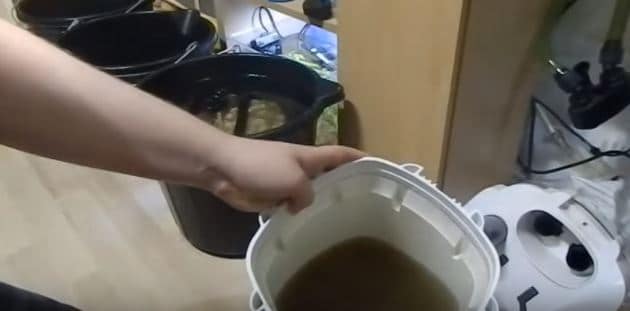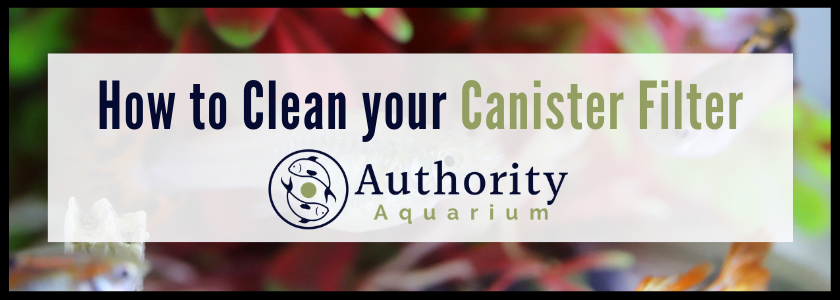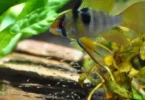Last Updated on April 24, 2023 by Coral Realm
Aside from the glass walls of a fish tank, the aquarium filter is the most important aspect to the safety of any fish living in any artificial body of water. Learning how to clean a canister filter is essential to the life and long term well being of your aquarium fish. You are looking after a delicate mini ecosystem.
The filter should make maintaining a fish tank a relatively simple task, as it works around the clock to keep water clean, purified and hosts beneficial bacteria needed to ensure good water quality.
Unfortunately, filters commonly get clogged, and need regular maintenance in order to stay running smoothly.
We’ll also talk in depth about how beneficial bacteria in filter medium is part of the filter’s ability to keep a tank clean. It’s not just about removing dirt and particles from water. This is essential knowledge for any fish keeper.

IN THIS ARTICLE
When to clean a canister filter
There are many reasons why we need to clean an aquarium canister filter, but they’re not always obvious.
The chances are that you probably already have some kind of system or schedule in place when it comes to cleaning your aquarium. In addition to performing weekly water changes, you probably also perform a larger water change once a month and replace your filter media. But when do you clean your tank filter? Do you clean it at all? If you want to keep your tank clean and running properly, you need to include your aquarium filter in your routine cleaning schedule.
Cleaning a canister filter will often depend on three main things:
- The type of filter you have
- How often you do a water change
- If the filter is slowing down
Other factors come into play here, these are influences such as how many aquarium fish you have, often referred to as an aquarium’s ‘stock’. The best way to monitor when you need to change or clean a filter is based on how the outflow of the filter is functioning. A slow output usually indicates clogging, and very rarely a mechanical issue. The other obvious way to detect filter efficiency is just to judge the dirtiness of the tank. If your filter contains fine filters, often seen in canister filters as the final polishing filter, then these can get clogged much more quickly and will slow down the output faster.
Cleaning your filter isn’t a one size fits all process. You have to clean the filter depending on the type of filter installed. Obviously, some filters come with a instruction booklet on this, but they don’t always take into account biological factors. For example, if you’re reusing filter material, you must clean it using purified and treated (fish safe) water.
How to clean your canister filter

Aquarium filters work in more ways than simply collecting dirt from the tank. Beneficial bacteria (a lot like those good gut drinks we’re always being sold) live in the filter medium that actually keep water quality stable and safe for fish. They attempt to mimic the natural ecosystem filter found in dense plantation and substrate where fish naturally live. Cleaning the canister filter is therefore a delicate process. Any sudden changes in water quality can cause your fish to go into shock.
There are several things you need to keep in mind when you then clean or replace parts of a filter. The first is that you never replace all the filter medium in one go. Usually, I never replace mine until they have become impossible to clean. This applies to all types of filtration media, from sponges to medium like MarineLand Ceramic Filter Rings. If you replace the filter medium all in one go, you loose ALL of the beneficial bacteria. We cannot over emphasize the importance of beneficial bacteria in a canister filter. They make up the biological filter, and remove ammonia and nitrite from the water column. Both of these are dangerous nitrogenous
When you clean canister filter media, instead of replacing it, you have to be careful not to kill the bacteria that are living in the filters. That means not using tap water to rinse them in. Tap water contains chlorine, chloramine, and other dangerous chemicals such as heavy metals. If you rinse and clean aquarium filter media in tap water you will kill the bacteria living amongst the media. The best thing to do is take a bucket of aquarium water out and clean the filter medium in that. You can also treat tap water before you use it by using a water conditioner. This preserves a lot of the bacteria and simply removes the big dirt buildups that were clogging the filter. This is vitally important, again, Do Not Clean Filter Media In Untreated Tap Water!
How to clean an aquarium filter depends on the type of filter medium have. First of all you will need to unplug and take your canister filter to the sink. Let’s get stuck into it:
Mechanical media
Mechanical media is the first up in water cleaning in all filters, including HOB filters, not just canister filters. This is because they are designed to filter out larger bits of floating debris such as feces and uneaten food. There are two main types of mechanical filtration media; filter sponges and filter floss. Filter sponges are quite coarse, catching large debris but letting water flow through uninhibited. This media is mainly used to prevent the large debris from clogging the rest of the filter. Filter floss is very fine and catches small floating debris that makes its way through the filter sponge.
- Filter sponge.
This is the bread and butter of most filters. In a lot of cheaper or smaller filters this is the only type of medium available. This type of coarse filter media is easily cleaned, and should rarely be replaced. It only needs replacing when it is literally falling apart. You can clean filter sponges in a bowl of aquarium or treated tap water, and shaking and squeezing it to get the caught gunk out. Using multiple small bowls of water works effectively. Treated tap water might actually be more beneficial for mechanical media as you can see when the water runs clear that the sponge is clean.
The filter will still contain beneficial amounts of bacteria even after being rinsed in aquarium water or treated tap water. It will often be paired with at least one other filter sponge, so it is recommended to clean one at a time. Or if your canister filter has two filter sponges, clean one fully and only lightly clean the second. If you have three, clean two and get the large debris from the third etc. If you do need to replace a filter sponge, only replace one at a time. Definitely do not replace more than one! If you replace all of them at once you will remove a large chunk of biological filtration power.
- Filter floss.
Also known as a polishing filter, it’s meant to be the last filter water will flow through before returning to the tank. It’s not to prevent clogging in the rest of the filter, the main sponge takes care of the ‘big bits’, it simply collects the tiniest particles of dirt that weren’t caught by the main filter. Sometimes it can be found behind the filter sponge as well. Usually you’ll have a very clean tank when you use filter floss. It usually clogs up fast and is difficult to clean because the sponge is so fine. You should clean it every 2 to 4 weeks, in aquarium water. Shake it vigorously to get the debris out. It will be obvious when filter floss needs replacing. They get absolutely filthy! If you’re unable to clean it, you should just replace the polishing filter.
Chemical Media
Chemical Filters are filters than contain a special type of filter medium that clean the tank in an unconventional way. By far the most common chemical filter media is activated carbon, which absorbs odors, discolorations, and tannins, amongst other things. Also common are zeolite and synthetic chemical media as as Seachem Purigen. All chemical media remove pollutants which are dissolved in the water, and so can’t be removed by the action of mechanical media. These are chemicals such as dyes, heavy metals, odors, and other impurities.
Some chemical media, however, after prolonged use can actually release the dyes and heavy metal back into the water. Media such as activated carbon and zeolite cannot be cleaned or regenerated, and so needs to be replaced entirely about every 1 to 2 months. Read the manufacturers instructions on replacement times though.
Synthetic media such as Seachem Purigen can be regenerated, and so doesn’t need to be replaced entirely every time. To do this the manufacturer will provide detailed instructions, and it can differ between products. For instance, with Purigen, it can be regenerated with a bleach and water solution, which ‘burns off’ the organic waste it has adsorbed.
Biological Media
Biological filters are full of good bacteria important for aquarium filtration. These nitrifying bacteria are part of the aquarium nitrogen cycle, and convert the ammonia produced when organic waste breaks down into nitrite, and then converts nitrite into nitrate. Ammonia and nitrite are very dangerous and poisonous to fish even at low concentrations, whereas nitrate is by far much less so.
Cleaning biological filtration media is easy; you simple gentle submerge it in aquarium water and gently shake it to remove any caught debris. It is best to do this in aquarium water, not treated tap water, though if you are in a pinch you can use treated tap water. This is because the biological media is where the vast majority of beneficial nitrifying bacteria colonize, so you want to do as little as possible to disturb it. Do not rinse this media thoroughly, as you’ll wash off all the bacteria. Most common in canister filters, they provide a high cylindrical surface area and thus are a hub of bacteria.
Usually, I will only replace a biological filter if the parts are crumbling or so filthy if will affect the speed of the pump.
Canister Filter Body
It isn’t only the filtration media that needs cleaning, the actually body of the canister filter and all the workings also need to be cleaned as well. Slime will be covering the impeller shaft, the impeller, the tubing, and the case of the canister filter. This needs to come off! To do this you need to take your canister filter apart.
The filter media baskets should come out fairly easily. For instance in the Fluval FX6 canister filter the media baskets are very easily to both remove and put back in after cleaning. The same can be said about the Eheim canister and Penn Plax canister filters. The media baskets can be rinsed and cleaned as well. It is recommended to use treated water for this as well. We simply use a new kitchen sponge and wipe the slime and dirt from the media baskets. We do the same for the canister filter casing as well. Use some elbow grease and get that dirt off!
The impeller shaft and impeller should come out fairly easily as well. Rinse this very carefully to get the dirt and slime off. In many canister filters the impeller shaft is ceramic and can break fairly easily, so be careful!
If there is any water in the body of the canister filter simply pour it down the sink. This water will be disgustingly dirty, so be rid of it!
Putting it back together
Once you have finished cleaning your canister filter you will need to put it all back together. Be very carefully with the impeller and impeller shaft, especially if they are ceramic. It is a total nightmare if either of these is accidentally broken.
Restack the filter media baskets as they were originally found; this will be the order in which the water flows through the baskets. First should be the mechanical media, then chemical, and finally biological media.
Carry the newly cleaned canister filter back to your aquarium, and refit the tubing. Plug it back into the outlet and you will have to prime the filter.
Priming will be different depending on which canister filter you have. Some are self priming, some have priming bulbs and buttons, while some you will need to prime yourself. Once this is done you can sit back and watch your clean canister filter at work!
Hopefully this article has been imformitive and useful. This video from Jacob’s Aquarium is a great guide to cleaning canister filters if you are a visual learner!
How do you clean your canister filter? Let us know in the comments!






